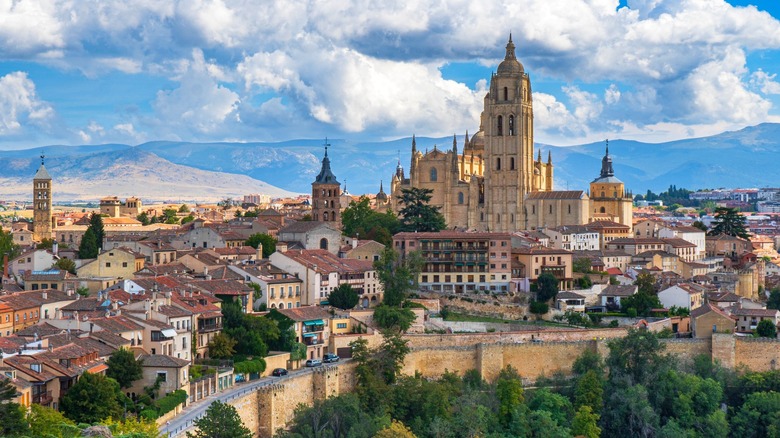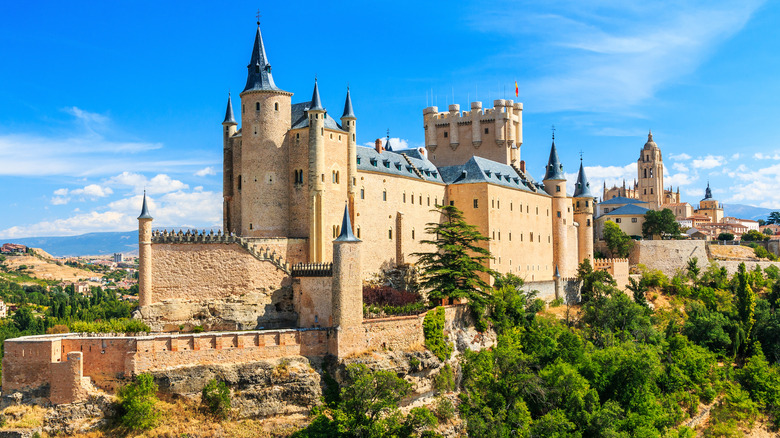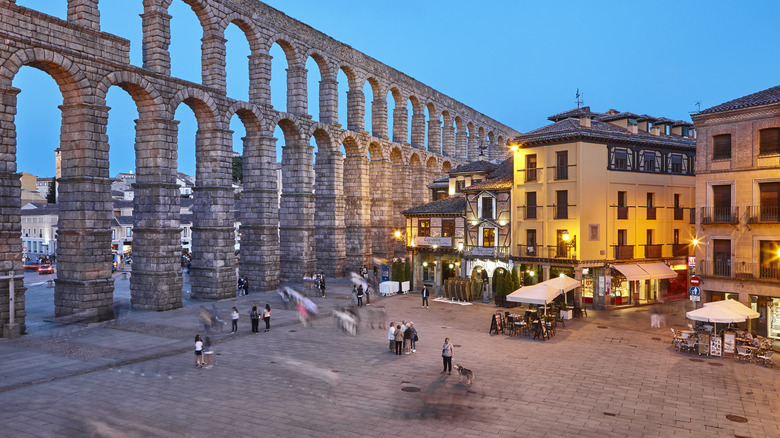In The Center Of Spain Is A Charming Underrated City Famed For Fairytale Architecture And Medieval Charm
Casting a colossal shadow over the ancient, cobbled streets of Segovia, a vast aqueduct has lined the landscape since the first century A.D. Spain's largest living monument from the era of the Roman Empire, the aqueduct crowns layers of architectural influence from the populations that have passed through the city in its thousands of years of history. Roaming along its slim streets you'll see the key-stone stacked stones of the Romans, elements of the Moorish influence that swept the soulful and vibrant cities of southern Spain, and the spindling turrets of Romanesque churches and the monumental castle. With all this historical beauty, it might be time to avoid the crowds in Barcelona and bypass Madrid's high-octane big city rush and opt instead for a walk through the small city of Segovia.
To get to Segovia, you should fly into Madrid. With direct flights running from 13 US airports to Adolfo Suárez Madrid–Barajas Airport, it's an easy connection from many stateside travel hubs. From there, accessing the small city from the Spanish capital is straightforward. Either rent a car and cruise through the country hills for a little over an hour or hop on a budget-friendly high-speed AVE train from Centro Station to arrive in Segovia in under half an hour.
Once you're in town you can utilize the local buses, but the small city's best attractions can all easily be explored on foot, especially given that the weather is almost never so severe that it would spoil your stay. That being said, it is still prone to fall showers, scorching summers, and brisk winters, so if you can, try to plan your travels in a shoulder season month like May, June, or September.
Walk through history on the ancient streets of Segovia, Spain
The entirety of the old city of Segovia is designated as a UNESCO World Heritage Site. Every street corner and every stone-wrought step is underlaid by centuries of stories, ready for inquisitive travelers to unravel. Start out on an informal walking tour through the city's historic heart, beginning at the foot of the gigantic Roman aqueduct in Plaza del Azoguejo. Peer up at two-ton blocks of rock stacked so precisely that no adhesive was needed, a signature of perfectly planned Roman design.
Carry on to the nearby Jewish Quarter, which housed a Hebrew community for hundreds of years. Under its old archways, worshippers once walked to the area's five former synagogues and its Talmudic schools, until Christendom turned its attention away from its Islamic neighbors and ordered the expulsion of all Jews from the city in 1492. Passing the vestiges of the lost Jewish community, head towards the meticulously carved facades of the Gothic cathedral. A vast, imposing sanctuary of the 16th century, you can dip inside to explore the grandiose interior.
Finish your ascending walk at the city's crowning gem: the Alcazar of Segovia. A fortress that inspired Disney's construction of Sleeping Beauty's castle, this royal home once hosted the preeminent figures of the Reconquista, Ferdinand and Isabella, and played host to scenes from the infamous Spanish Inquisition. The resplendent Alcazar, with its spires and turrets, cuts an iconic figure against the Castilian hills. Take a guided tour, explore the maze of interior halls, or climb the 152 steps to the top of the main tower for panoramic city views.
Try traditional Spanish food in Segovia
Not short on cities hailed as small tastes of paradise for food and wine lovers, Spain's sumptuous but stripped back cuisine spotlights different ingredients in each of its distinct autonomous divisions. In Castile-Leon, the mountain fringed plateau over which Segovia sits, the locals favor hearty fare. Suckling pigs sizzle over open flames, lamb meat falls off of roasted leg bones, and hares hunted in the fields are stewed and soaked up with torta cenceña (flat, unleavened bread). Segovia's chefs can lean on their region's florescent fields of saffron, freshly formed Manchego cheeses, and foraged wild mushrooms to create decadent meals for visiting diners.
Stop in at Restaurante José María for old-school Spanish stylings and generous portions of pork. This is the perfect place to try Segovia's cherished dish, asado cochinillo, a whole fire-roasted piglet with skin crisped into a crackling crust. It's the signature dish of the restaurant, as well as of the region, and the pigs are each raised on the family's own farm. For a lighter option, snack on a selection of delectable Iberian surtidos, or cold cuts, paired with Spanish tomatoes, fresh breads, and a decadent serving of olive oil.
Quick bites for busy travelers are also easy to find in Segovia's historic center. Keep an eye on out for menus touting hornazos, tarts made with sausage and egg, torreznos, Spain's answer to cured chicharron, or ponche Segoviano, a sponge cake in which each layer is soaked in syrup.


